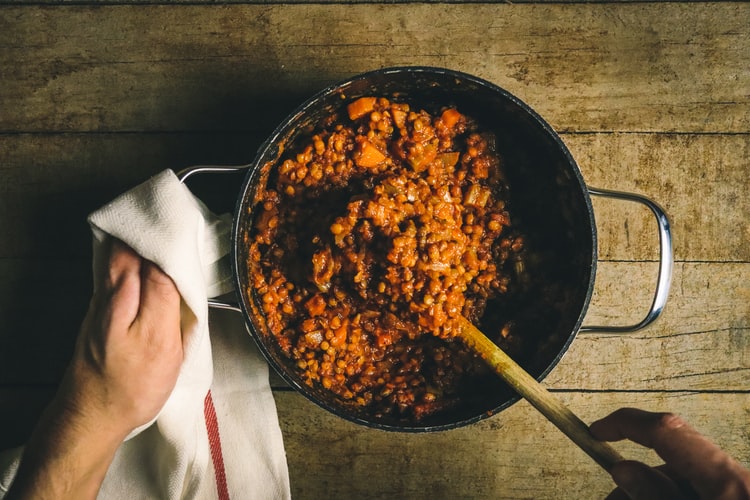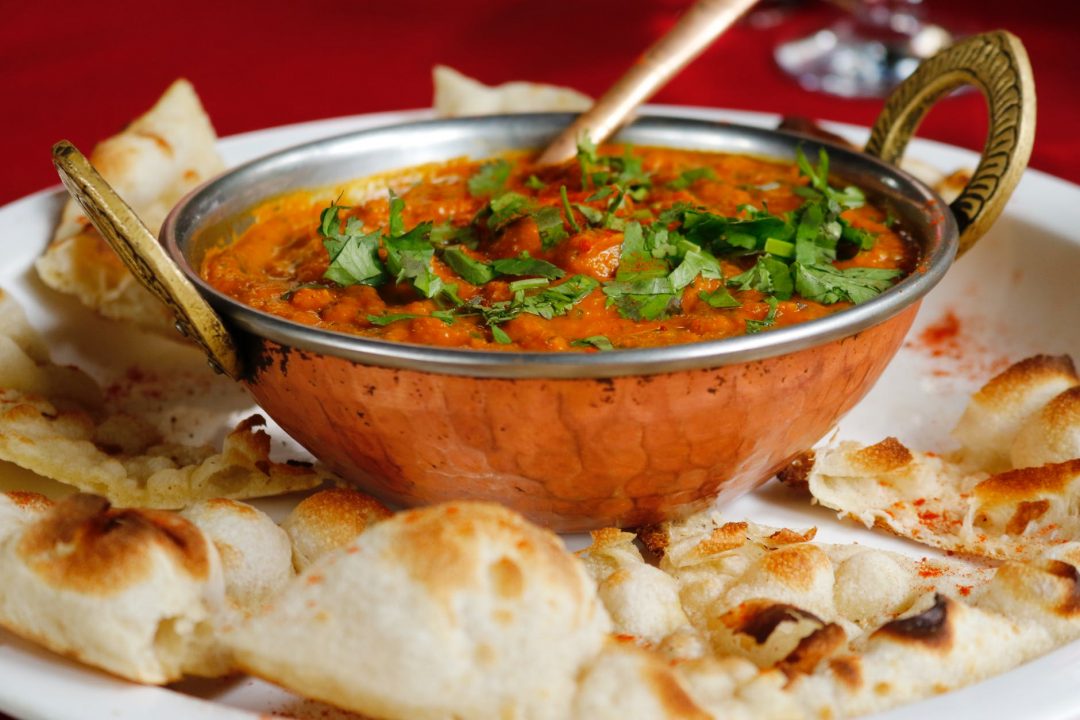Bring ancient Ayurvedic cooking principles into your home and transform everyday ingredients into dishes to balance your mind, body and soul.
The medicinal philosophy of Ayurveda has deep roots in the Indian subcontinent. It is based on the theory that we are all made of different types of energy.
This ancient Vedic system – a 5000-year-old practice – seeks to create harmony and balance between the different energies found in our bodies for physical, emotional, and mental wellbeing. Over the last few of decades, travellers have flocked to India to learn more about Ayurveda firsthand.
Food plays an integral role in the tradition of Ayurveda. Eating and cooking meals that do right by your dosha can help the mind, body and soul feel sound. Not to mention that some of our favourite comfort dishes – like kitchari – from the Indian subcontinent have a rich heritage of Ayurveda.
In this food guide, we show you how to embrace Ayurvedic cooking principles in your kitchen.

What is Ayurvedic food?
The Ayurvedic way of eating has been around for thousands of years. It is believed that food is one of the best ways to balance our energies in order to promote more wellbeing. In countries such as India, Nepal, and Sri Lanka, Ayurveda is considered a serious medical practice.
In the tradition of Ayurveda, five elements make up the universe: vayu (air), jala (water), akash (space), teja (fire), and prithvi (earth). These elements come together and form three different doshas – Pitta, Vata, and Kapha – and each one of these doshas regulates certain functions within the body.
While a combination of all three doshas resides within all of us, the belief in Ayurveda is everyone has a dosha that is more prominent. However, you can do things to feed the other two doshas, for example, by eating certain types of food to balance things out. Different tastes are recommended to each of the three doshas, and in total there are six tastes.
- Sweet (earth and water): Foods like whole grains, rice, seeds and nut fall under this category, along with many fruits and vegetables. In Ayurveda, sweet tastes are believed to satiate our hunger, give us energy and also promote a sense of calm.
- Sour (earth and fire): Culture-based dairy items like yoghurt, sour cream, and buttermilk are considered sour foods. Sour tastes are supposed to elevate our appetite levels, increase saliva and digestive juices, but it is not recommended to overeat these foods.
- Salt (water and fire): Eating food with naturally occurring salt can help to cleanse the body – seaweed, for example. Eating foods with too much-processed salt can lead to water retention and other imbalances in the body.
- Pungent (fire and air): This taste helps to reduce fluid retention and can help to improve focus and attention. Onions, ginger, and mustard are examples of pungent food.
- Bitter (air and space): This taste helps with digestion, teas and green leafy veggies are considered bitter foods.
- Astringent (air and earth): Fruits like apple, berries and grapes are considered astringent and mushrooms, celery and cucumber are some vegetables that would fall under this category.
Begin your journey by determining your dosha
Before you hit the kitchen, you need to understand which dosha is your most dominant. There are a number of resources you can use online to help you learn more about this, there’s even a dosha quiz you can take for free by signing up.
Here’s an overview of the three different doshas:
| Dosha | Element | Physique | Personality | Food profile |
| Pitta | Fire and water | Medium build, warm, muscular | Passionate and driven | Will try everything |
| Vata | Air and space | Thin, light frame | Energetic and friendly | Spontaneous |
| Kapha | Earth and water | Heavyset and strong | Considerate and kind | Loves to eat |

Some foods to enjoy if you are Pitta
- Choose sweet, astringent, and bitter tastes
- Choose refreshing food (for example, a fruit salad)
- Avoid alcoholic and fermented foods
- Best veggies: asparagus, broccoli, Brussels sprouts, mushroom, cauliflower
- Grains: Oats, wheat and basmati rice
- Proteins: fish, turkey, lentils
- Best spices: cardamom, coriander seed, turmeric, cumin, black pepper
Some foods to enjoy if you are Vata
- Choose salty, sour, and sweet tastes
- Choose hearty foods (for example, a bowl of warm oatmeal)
- Avoid raw veggies and unripe fruit
- Best veggies: asparagus, carrots, green beans, onions, sweet potatoes
- Grains: oats and rice
- Proteins: chicken, chickpeas, small amounts of tofu
- Best spices: Cinnamon, cardamom, cumin, ginger, garlic
Some foods to try if you are Kapha
- Choose pungent astringent and bitter tastes
- Choose warm light and dry foods (for example, grilled chicken tacos)
- Avoid dairy and chilled drinks
- Best veggies: Cabbage, eggplant, leafy greens, okra, potatoes
- Grains: Rye, basmati rice, corn
- Proteins: Chicken, fish, all legumes
- Best spices: Cumin, fenugreek, sesame, ginger

How to enjoy Ayurvedic cooking principles at home
Even without following dosha guidelines, you can embrace one of the traditions of Ayurveda by eating seasonally and by consuming spices that are recommended for your dosha. You can also explore elements of this ancient practice by making dishes to balance your mood. So if you are feeling fiery, you can eat something cooling (sorbet), and if you are feeling airy, you can create a dish that will help you feel more grounded (root vegetables).
Some key things Ayurvedic cooking principles to keep in mind:
- Try to cook foods according to your dosha
- Stock up on Ayurvedic pantry staples like ghee and coconut oil, and anti-inflammatory turmeric, ginger and cardamom
- Learn how to make kitchari – it’s one of the most nourishing dishes you can eat
- In general, try not to overcook food
Comfort dishes to cook for your dosha
Time to turn up – or depending on your dosha – turn down the heat in your kitchen! Now that you have a little more understanding of how to eat the Ayurvedic way, we’re going to show you how to balance your energies with suggested appetizers, entrées and dessert recipes. All of the meals are linked to a recipe.
Exploring food from an Ayurvedic perspective is a different way to enrich your palette and one that could prove to be quite transformative not just for your tastebuds but for your mind, body and soul!

Dinuka Lankaloka/Unsplash
Dishes to try if you’re Pitta
Pittas should try out recipes that don’t have to be served piping hot, and anything that is cooling and refreshing is ideal!
Appetizer
- Grilled chicken seekh kebabs with mini chutney: Minced chicken is marinated overnight with black pepper, salt, fresh coriander, cumin, onions, ginger, and garlic, and then shaped onto a skewer before being cooking in a grill or frying pan. Serve it with a cooling mint and yoghurt chutney.
Entrée
- Maash ke daal and roti: This dry daal dish is made with white urad lentils and cooked with onions, ginger and garlic. It’s a little lighter on spices and tastes delicious with homemade roti.
Dessert:
- Coconut kulfi: Rich, cooling and refreshing all that the same time, kulfi is a popular dessert made out of milk boiled with sugar and shredded coconut.
Dishes to try if you’re Vata
Vatas should try out hearty warm recipes, dishes like stews and soup are perfect!
Appetizer:
- Flaky baked vegetable samosas and mango chutney: The ultimate desi snack, this rendition is made with flaky puff pastry and then baked in the oven. Serve them with a sweet and tart mango chutney.
Entrée:
- Palak paneer with basmati rice: Toasted cubes of paneer cheese are simmered in an aromatic gravy of creamed spinach. It tastes delicious served on top of steaming hot basmati rice.
Dessert:
- Chai-spiced oatmeal apple crisp: Think apples stewed with cinnamon, cardamom, ginger and cloves topped off with a buttery oatmeal topping.
Dishes to try if you’re Kapha
While Kaphas should avoid heavy foods, that doesn’t mean eating food that isn’t satisfying!
Appetizer:
- Pan-fried masala fish: This iconic dish can be made with almost any white fish and any combination of spices. Just marinate your chosen fish with garlic and ginger and colourful spices like pink salt, turmeric and cumin, and pan-fry in a couple of tablespoons of oil. Serve with some wedges of fresh lemon.
Entrée:
- Sarson ka saag with makki ki roti: Bitter mustard greens are cooked down with fragrant ingredients like onion, garlic and ginger and serve with a side of charred corn flatbreads.
Dessert:
- Chaat Masala Fruit Salad: This zingy fruit salad is eaten throughout India and Pakistan. Fresh seasonal fruit is mixed with a spicy masala mix known as “chaat” which usually has ingredients like ginger and dried mango powder.
Note: This article is for informational purposes only, and is not intended to be a substitute for advice provided by a doctor or other qualified healthcare professionals.


